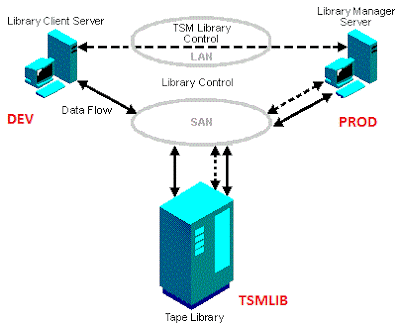1) How to start TSM B/A Client schedule services in AIX in background?
2) How to start TSM web client services in AIX ?
3) How to start B/A client in web-browser ?
4) How to start the TSM LANFree storage agent services in AIX ?
5) How to check the TSM services are running in AIX ?
6) How to start the TSM services in AIX ?
and then run below command to start in background
7) How to kill the TSM services in AIX ?
First check the services by using ---- > # ps -ef | grep -i dsmserv
It will list out the process id's, then cancel the process id by using below command
8) How to check the tape devices list in AIX ?
9) How to check the adapters in AIX ?
10) How to check the errors in OS level in AIX ?
12) How to create the new file in AIX ?
13) How to read last 200 lines in any file ?
14) How to check the file size in AIX ?
15) How to verify the list of files in a directory ?
16) How to change the ownership of the file ?
17) How to copy the file from one dir to another dir ?
18) How to check the IP address in AIX ?
19) How to check the hostname of the server ?
20) How to check the communication b/w from one server to another server in AIX ?
21) How to check if the port number is working or not in AIX ?
22) How to create a new directory in AIX ?
23) how to move (cut/paste) the files form one directory to another directory in AIX?
24) To remove/delete the directory and files in AIX ?
25) To check which software applications are installed in AIX ?
26) How to edit any file, for example dsm.sys file ?
use i to go to insert mode, a to append mode , x to delete letters
27) How to change permissions of a file/directory ?
28) How to configure tape devices in AIX ?
Running cfgmgr command will scan all the devices attached to the AIX machine
29) How to install any software packages in AIX ?
30) How to uninstall software packages for example all the tsm client softwares ?
Go to /opt/tivoli/tsm/_uninst and run ./Uninstall_Tivoli_Storage_Manager -i console command
# cd /usr/tivoli/tsm/client/ba/bin
# nohup dsmc sched &
2) How to start TSM web client services in AIX ?
# nohup dsmcad &
3) How to start B/A client in web-browser ?
http://ip.address.of.server>:1581
4) How to start the TSM LANFree storage agent services in AIX ?
# cd /usr/tivoli/tsm/StorageAgent/bin
# nohup ./dsmsta &
5) How to check the TSM services are running in AIX ?
# ps -ef | grep -i dsmserv
6) How to start the TSM services in AIX ?
For TSM 5.5 --> # cd /usr/tivoli/tsm/server/bin
For TSM 6.X --> # cd /opt/tivoli/tsm/server/bin
and then run below command to start in background
# ./dsmserv &
7) How to kill the TSM services in AIX ?
First check the services by using ---- > # ps -ef | grep -i dsmserv
It will list out the process id's, then cancel the process id by using below command
# kill -9 <PID no>
8) How to check the tape devices list in AIX ?
# lsdev -Cc tape
9) How to check the adapters in AIX ?
# lsdev -Cc adapter
10) How to check the errors in OS level in AIX ?
# errpt -a
11) How to check the tape serial number in AIX ?
# lscfg -vpl <devicename> (Ex- rmt1)
12) How to create the new file in AIX ?
# cat>file name OR
# touch <filename> OR
# vi <filename>
13) How to read last 200 lines in any file ?
# tail -200 <filename>
14) How to check the file size in AIX ?
# df -k <filesystemname> (To check in kbs)
# df -m <filesystemname>(To check in mbs)
# df -g <filesystemname> (To check in gbs)
15) How to verify the list of files in a directory ?
# ls -ltr
16) How to change the ownership of the file ?
# chown username:groupname <filename>
17) How to copy the file from one dir to another dir ?
# cp <filename> /dir/dir/<filename>
18) How to check the IP address in AIX ?
# ifconfig -a
19) How to check the hostname of the server ?
# hostname
20) How to check the communication b/w from one server to another server in AIX ?
# ping ipaddress
21) How to check if the port number is working or not in AIX ?
# netstat -an <portnumber>
ex: # netstat -an 1500
22) How to create a new directory in AIX ?
# mkdir <directoryname>
23) how to move (cut/paste) the files form one directory to another directory in AIX?
# mv /dir1/dir2<filename> /dir4/dir5/dir6/<filename>
24) To remove/delete the directory and files in AIX ?
# rmdir -r <dirname> -r --> deletes subdirectories also
25) To check which software applications are installed in AIX ?
To check TSM, run ------- > # lslpp - l tivoli.tsm*
26) How to edit any file, for example dsm.sys file ?
# vi dsm.sys
use i to go to insert mode, a to append mode , x to delete letters
27) How to change permissions of a file/directory ?
# chmod 777 <file/dirname>
Running cfgmgr command will scan all the devices attached to the AIX machine
# cfgmgr
29) How to install any software packages in AIX ?
using # smitty installp OR
# installp -agXd /softwares/install.bin
Ex: # installp -agXd .tsmsoft/install.bin
# smitty remove tivoli.tsm.*
# installp -ug tivoli.tsm.*
Go to /opt/tivoli/tsm/_uninst and run ./Uninstall_Tivoli_Storage_Manager -i console command





